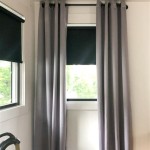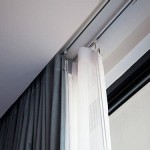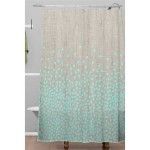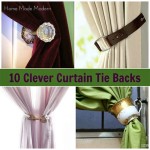How Far Out Should Curtain Rods Extend?
Determining the appropriate extension of curtain rods beyond the window frame is a critical element in achieving both aesthetic appeal and optimal functionality in window treatments. The placement significantly impacts the amount of natural light entering a room, the perceived size of the window, and the overall ambiance of the space. Neglecting this aspect of curtain installation can lead to a less polished and potentially awkward appearance.
The ideal extension is not a one-size-fits-all solution; rather, it depends on a variety of factors, including the size and style of the window, the fabric and weight of the curtains, and the desired aesthetic effect. A well-considered decision regarding curtain rod extension can enhance the architectural features of the room and contribute to a more cohesive and visually pleasing interior design.
Maximizing Light and Visual Space
One of the primary benefits of extending curtain rods beyond the window frame is the ability to maximize the amount of natural light that enters the room. When curtains are fully open, they can be stacked off the windowpane itself, allowing a greater expanse of glass to be exposed. This is particularly advantageous in rooms that tend to be darker or those where natural light is highly valued, such as living rooms and home offices.
Extending the rod also creates the illusion of a larger window. By hanging curtains wider than the actual window opening, the eye is tricked into perceiving a greater expanse of glass. This technique is especially useful in smaller rooms or rooms with smaller windows, where maximizing perceived space is a priority. The difference, while subtle, can significantly impact the overall feeling of openness and airiness within the room.
The specific distance of the extension will depend on the window's size and the desired effect. However, a general guideline suggests extending the rod at least 3 to 6 inches beyond the window frame on each side. For wider windows, a greater extension may be necessary to adequately stack the curtains and achieve the desired look. Careful consideration should be given to the architectural context of the window and the room as a whole.
Conversely, rooms with an abundance of natural light may benefit from a smaller extension. In these cases, the goal may be to simply frame the window without maximizing light exposure. A narrower extension can create a more intimate and cozy atmosphere, which might be preferable in bedrooms or media rooms. Ultimately, the decision rests on the individual preferences and the specific needs of the space.
Considering Curtain Weight and Fabric
The weight and fabric of the curtains are essential factors to consider when determining the proper extension of the curtain rod. Heavier fabrics, such as velvet or blackout linings, require sturdier rods and potentially larger extensions. The added weight necessitates a more robust support system to prevent the rod from sagging or pulling away from the wall.
A longer extension may also be necessary to accommodate the bulk of heavier curtains when they are fully open. Insufficient extension may result in the curtains obstructing part of the window, negating the benefit of maximizing light exposure. The extra space allows the curtains to be neatly stacked off the window, ensuring a clean and unobstructed view.
Lighter fabrics, such as linen or sheer materials, are less demanding in terms of support and stacking space. However, even with lighter curtains, a sufficient extension is still important to achieve the desired aesthetic effect. A slightly longer extension can prevent the curtains from looking skimpy or inadequate, particularly on larger windows.
The type of curtain heading, such as grommets, pleats, or rod pockets, also influences the required extension. Curtains with grommets or pleats tend to stack more compactly than those with rod pockets, potentially allowing for a slightly shorter extension. However, it is always best to err on the side of caution and ensure that the rod is long enough to accommodate the curtains comfortably.
It's prudent to consider the stack back, which refers to the width of the curtains when they are fully drawn to the side. Measure the stack back of the chosen curtains before installing the rod to ensure that the extension provides sufficient space for the fabric to be neatly arranged off the window. This step is crucial for achieving a polished and professional look.
Aesthetic Considerations and Room Proportions
Beyond functionality, the extension of curtain rods plays a significant role in the overall aesthetic appeal of a room. The placement and length of the rod can be used to create visual balance and harmony, enhancing the architectural features of the space. A well-chosen extension can complement the room's style and contribute to a more cohesive design.
In rooms with low ceilings, hanging curtains high above the window frame and extending the rod beyond the sides can create the illusion of greater height. This technique draws the eye upward, making the room feel more spacious and airy. The vertical emphasis can be particularly effective in smaller rooms or those with limited natural light.
Consider the architectural style of the room when determining the appropriate extension. In more traditional spaces, a slightly longer extension may be preferred to create a sense of grandeur and formality. In contrast, more contemporary spaces may benefit from a shorter extension to maintain a clean and minimalist aesthetic.
The color and pattern of the curtains also influence the perceived size of the window and the overall impact of the extension. Bold colors and patterns tend to draw more attention, so a slightly shorter extension may be advisable to prevent the curtains from overwhelming the space. Conversely, neutral colors and subtle patterns can be enhanced with a longer extension to create a more dramatic effect.
The hardware chosen for the curtain rod also contributes to the overall aesthetic. Decorative finials can add a touch of elegance and sophistication, but they also increase the overall length of the rod. Be sure to factor in the size of the finials when determining the appropriate extension to ensure that the curtains hang properly and the proportions are visually pleasing.
Finally, it is important to consider the view outside the window. If the view is particularly appealing, a longer extension can help to maximize the amount of it that is visible when the curtains are open. Conversely, if the view is less desirable, a slightly shorter extension may be preferable to minimize its impact on the room's aesthetic.
In conclusion, the determination of how far out curtain rods should extend requires a careful consideration of multiple factors, including light maximization, curtain weight, and aesthetic preferences. Tailoring the extension to the specific needs of the room and the characteristics of the curtains is essential for achieving both optimal functionality and a visually pleasing design. By paying attention to these details, one can ensure that the window treatments enhance the overall ambiance and style of the space.

How Far Past A Window Should Curtains Go

How To Install Curtain Rods Best Practices The Shade
How To Hang Curtains In 7 Steps

How To Hang Curtains The Right Way Do It Yourself Fun Ideas

How To Install Curtain Rods 5 Simple Steps

How To Fit Curtain Poles Free Advice From Fabric Gallery Interiors

The Right Way To Hang Curtains And Drapes Fred Gonsowski Garden Home

How I Install Perfectly Even Curtain Rods Every Time Without A Level T Moore Home Interior Design Studio

Measuring Curtain Rod Width Order Length Labeled Abda Window Fashions

How To Fit Curtain Poles Free Advice From Fabric Gallery Interiors








